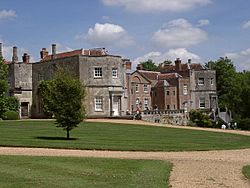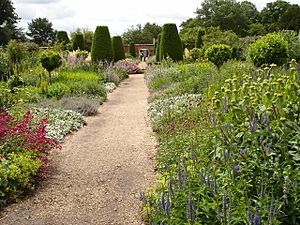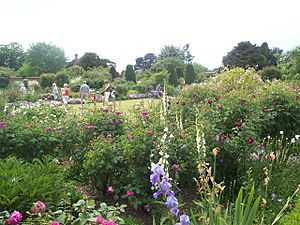Mottisfont Abbey facts for kids
 |
|
| Lua error in Module:Location_map at line 420: attempt to index field 'wikibase' (a nil value). | |
| Monastery information | |
|---|---|
| Order | Augustinian |
| Established | 1201 |
| Disestablished | 22 May 1536 |
| Dedicated to | The Priory Church of the Holy Trinity, Mottisfont |
| People | |
| Founder(s) | William Briwere |
| Site | |
| Location | Mottisfont, Hampshire, England |
| Visible remains | parts of church, chapter house and cellarium incorporated into 18th-century mansion |
| Public access | yes |
| Other information | National Trust |
|
Listed Building – Grade II
|
|
| Official name | Mottisfont Abbey House |
| Designated | 29 May 1957 |
| Reference no. | 1093730 |
| Official name | Abbey, Mottisfont |
| Designated | 31 May 1984 |
| Reference no. | 1000864 |
|
Listed Building – Grade II
|
|
| Official name | Walled garden 250 m north west of Mottisfont Abbey |
| Designated | 11 April 1986 |
| Reference no. | 1339147 |
Mottisfont Abbey is a special historical place in Hampshire, England. It used to be a priory, which is like a monastery for a group of monks called Augustinian canons. Later, it became a grand country estate.
Mottisfont Abbey is nestled in the beautiful valley of the River Test. Today, the National Trust, a charity that protects historic places, looks after it. In 2019, almost 400,000 people visited this amazing site.
When you visit, you can explore the historic house, which often has cool art exhibitions. There are also lovely gardens, including a special rose garden with many old and rare types of roses. You can also enjoy a peaceful walk along the river. Mottisfont Abbey is considered a very important historic building, known as a Grade I listed building.
Contents
History of Mottisfont Abbey
How Mottisfont Got Its Name
The area where Mottisfont Abbey stands was first settled because it had good land and plenty of water. The name "Mottisfont" comes from a natural spring, or "font," that still flows there today. This spring was where the local community used to hold their "moots," which were like important meetings.
Founding the Priory in 1201
In 1201, a priory was built here by a man named William Briwere. He was a successful businessman and worked for four different kings from the Plantagenet family. Building the priory was his way of showing his wealth and his strong religious beliefs.
The Augustinian canons (monks) who lived there welcomed pilgrims. These pilgrims were traveling to Winchester and would stop at Mottisfont to worship a special relic. This relic was believed to be a finger of St John the Baptist.
Changes After the Black Death
Mottisfont Priory was very successful at first. However, it faced hard times starting in the mid-14th century, especially after the terrible Black Death plague.
Later, during the time of King Henry VIII, many monasteries in England were closed down. This period was called the Dissolution of the Monasteries. The king gave Mottisfont Priory to one of his favorite statesmen, Sir William Sandys.
Sir William Sandys turned the priory into a country home. What was unusual was that he didn't tear down the old priory buildings. Instead, he used the main part of the old church (called the nave) as the central section of his new mansion. He then added new parts (wings) on either side. You can still see parts of the original medieval church today, with the newer additions built around them. A 13th-century cellarium, which was a storage room, also still exists.
Mottisfont Becomes an "Abbey"
In the 18th century, the Mill family owned Mottisfont. They pulled down the old monastic cloisters (covered walkways) and the Tudor courtyard. This is how the house got its modern look. It was also around this time that the owners started calling the house "Abbey" instead of "Priory." The National Trust thinks they might have done this because "Abbey" sounded more romantic.
Later, in the early 19th century, under Sir John Barker Mill, Mottisfont became a popular place for hunting, shooting, and fishing. A new stable block was built for horses.
Art and War at Mottisfont
Towards the end of the 19th century, a rich banker named Daniel Meinertzhagen rented Mottisfont. He had some unusual rules, like no electric lights or central heating! His children, including Daniel and Richard, built special aviaries for their collection of birds like eagles, hawks, owls, and ravens. Richard wrote a lot about his childhood and his growing interest in nature.
In 1934, Maud and Gilbert Russell moved into Mottisfont. They made it a lively hub for artists and important people. Maud was very wealthy and loved supporting the arts. She invited many famous artists and writers, like Ben Nicholson and Ian Fleming, to stay at Mottisfont.
Maud asked her artist friends to decorate the house, always keeping its history in mind. Rex Whistler painted a special picture in her drawing room (now called the Whistler Room). It was a clever painting technique called trompe-l'œil that made it look like there were old Gothic architecture arches, reminding everyone of the priory's medieval past. Boris Anrep created beautiful mosaics both inside and outside the house. One mosaic shows an angel with Maud’s face, as they had a long love affair.
During World War II, Mottisfont was used as a hospital with 80 beds to help wounded soldiers.
Mottisfont Joins the National Trust
Maud Russell gave Mottisfont Abbey and its grounds to the National Trust in 1957. She continued to live there until 1972.
One of the artists who often visited Mottisfont was Derek Hill. He was known for painting portraits of important people but also loved painting landscapes. He gave a large collection of early 20th-century art to the National Trust to be displayed at Mottisfont. He did this to honor his long friendship with Maud Russell. Today, Mottisfont often hosts new exhibitions of modern art alongside these older works.
Visiting Mottisfont Abbey Today
Mottisfont Abbey has amazing grounds that are just as interesting as the house itself. You can find shady wooded areas and enjoy a peaceful walk along the River Test. There are also large lawns where families can have picnics and play games.
The scented rose gardens are truly magnificent, especially on warm early summer evenings. Mottisfont is also home to the largest London plane tree in Britain. Many different types of visitors come here, from families to large groups of tourists.
On a warm summer day, Mottisfont is a perfect escape from the busy cities of Southampton and Romsey, which are both nearby.
During the summer, you can often watch outdoor theatre performances. At different times of the year, there are special trails, often designed for children, like during Easter, Halloween, or Christmas.
You can buy refreshments at several spots around the estate. There's also a modern National Trust shop, an ice cream parlor, and an exhibition space. A new Visitor Centre was built in 2016. It's an eco-friendly building that uses a special boiler to burn wood-chips from the estate for heating in winter.
The Test Way, a walking path, goes through Mottisfont and around the Abbey grounds. From this path, you can see the main house from the back as you walk through the fields.
Images for kids
See also
 In Spanish: Mottisfont Abbey para niños
In Spanish: Mottisfont Abbey para niños










